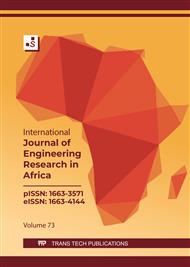[1]
F. Sick, S. Schade, A. Mourtada, D. Uh, and M. Grausam, Dynamic building simulations for the establishment of a Moroccan thermal regulation for buildings, J. Green Build., 9 (2014) 145-165.
DOI: 10.3992/1943-4618-9.1.145
Google Scholar
[2]
T. M. Hart and S. Brzev, The confined masonry network's design and construction guidelines, 10th U.S. National Conference on Earthquake Engineering, Alaska, January (2014).
Google Scholar
[3]
I. S. Misir and G. Yucel, Numerical Model Calibration and a Parametric Study Based on the Out-Of-Plane Drift Capacity of Stone Masonry Walls, Buildings, 13(2023) 1-18.
DOI: 10.3390/buildings13020437
Google Scholar
[4]
R. Marques, J. M. Pereira, and P. B. Lourenço, Lateral in-plane seismic response of confined masonry walls: From numerical to backbone models, Eng. Struct., 221(2020)111098.
DOI: 10.1016/j.engstruct.2020.111098
Google Scholar
[5]
A. A. Adam Mohammed, M. Fener, R. Comakli, İ. İnce, M. C. Balci, and K. Kayabalı, Investigation of the relationships between basic physical and mechanical properties and abrasion wear resistance of several natural building stones used in Turkey, J. Build. Eng., 42(2021)103084.
DOI: 10.1016/j.jobe.2021.103084
Google Scholar
[6]
L. Long, Q. Li, Z. Gan, J. Mu, M. Overend, and D. Zhang, Life cycle assessment of stone buildings in the Taihang mountains of Hebei province: Evolution towards cleaner production and operation, 399(2023)136625
DOI: 10.1016/j.jclepro.2023.136625
Google Scholar
[7]
R. Marques and P. B. Lourenço, Structural behaviour and design rules of confined masonry walls: Review and proposals, Constr. Build. Mater., 217(2019)137-155.
DOI: 10.1016/j.conbuildmat.2019.04.266
Google Scholar
[8]
F. Sitzia, C. Lisci, and J. Mirão, Building pathology and environment: Weathering and decay of stone construction materials subjected to a Csa mediterranean climate laboratory simulation, Constr. Build. Mater. 300(2021)124311.
DOI: 10.1016/j.conbuildmat.2021.124311
Google Scholar
[9]
C. Thomachot-Schneider, P. Vazquez, M. Gommeaux et al., Thermal response of building stones contaminated with salts, Constr. Build. Mater. 226(2019)331-344.
DOI: 10.1016/j.conbuildmat.2019.07.127
Google Scholar
[10]
B. Sohrabian and Y. Ozcelik, Joint simulation of a building stone deposit using minimum/maximum autocorrelation factors, Constr. Build. Mater., 37(2012) 257-268.
DOI: 10.1016/j.conbuildmat.2012.07.033
Google Scholar
[11]
F. Anjum, M. Yasin Naz, A. Ghaffar, K. Kamran, S. Shukrullah, and S. Ullah, Sustainable insulating porous building materials for energy-saving perspective: Stones to environmentally friendly bricks, Constr. Build. Mater., 318 (2021)125930.
DOI: 10.1016/j.conbuildmat.2021.125930
Google Scholar
[12]
E. Donval, D. T. Pham, G. Hassen, P. de Buhan, and D. Pallix, A numerical homogenization method for the determination of the thermal bowing of a masonry wall exposed to fire: Application to natural stone masonry, Engineering. Structures., 266(2022)114541.
DOI: 10.1016/j.engstruct.2022.114541
Google Scholar
[13]
D. Beggas and J. Zeghiche, The use of slag stone concrete to improve the thermal performance of light steel buildings, Sustain. Cities Soc., 6(2013)22-26.
DOI: 10.1016/j.scs.2012.07.004
Google Scholar
[14]
L. Georgiou, C. Panteli, A. Kylili, and P. A. Fokaides, Thermal performance of brick and stone masonry: Cumulative heat flux dataset for main orientations and under diverse seasonal conditions, Data in Brief., 33(2020) 106599.
DOI: 10.1016/j.dib.2020.106599
Google Scholar
[15]
A. Blumberga, R. Freimanis, E. Biseniece, and A. Kamenders, Hygrothermal Performance Evaluation of Internally Insulated Historic Stone Building in a Cold Climate, Energies, 16(2023)866.
DOI: 10.3390/en16020866
Google Scholar
[16]
G. G. Akkurt et al., Dynamic thermal and hygrometric simulation of historical buildings: Critical factors and possible solutions, Renew. Sustain. Energy Rev., 118(2019)109509.
DOI: 10.1016/j.rser.2019.109509
Google Scholar
[17]
M. Shaqfa and K. Beyer, A virtual microstructure generator for 3D stone masonry walls, Eur. J. Mech. A/Solids, 96(2022)104656.
DOI: 10.1016/j.euromechsol.2022.104656
Google Scholar
[18]
A. Schiavi, G.Cellai , S.Secchi, F.Brocchi, A.Grazzini, A.Prato, F.Mazzolen., Stone masonry buildings: Analysis of structural acoustic and energy performance within the seismic safety criteria, Constr. Build. Mater., 220(2019)29-42.
DOI: 10.1016/j.conbuildmat.2019.05.192
Google Scholar
[19]
S. Scrivano, L. Gaggero, and J. Gisbert Aguilar, An Experimental Investigation of the Effects of Grain Size and Pore Network on the Durability of Vicenza Stone, Rock Mech. Rock Eng., 52(2019)2935-2948.
DOI: 10.1007/s00603-019-01768-x
Google Scholar
[20]
A. Martinez-Molina, K. Williamson, and W. Dupont, Thermal comfort assessment of stone historic religious buildings in a hot and humid climate during the cooling season. A case study,Energy Build., 262(2022)111997.
DOI: 10.1016/j.enbuild.2022.111997
Google Scholar
[21]
Le Règlement Thermique de Construction au Maroc, [dissertation], AMEE 2015.
Google Scholar
[22]
S. Raefat, M. Garoum, N. Laaroussi, and Y. Chihab, A simple laboratory flash apparatus for thermal diffusivity measurement: Modeling and application for composite material based on clay and straw, Case Stud. Constr. Mater., 15(2021)e00657.
DOI: 10.1016/j.cscm.2021.e00657
Google Scholar
[23]
Plastics-Differential scanning calorimetry (DSC)-Part 4: Determination of specific heat capacity, ISO 11357-4:2014, 2014.
DOI: 10.3403/30291940
Google Scholar
[24]
Ergonomics of the thermal environment — Analytical determination and interpretation of thermal comfort using calculation of the PMV and PPD indices and local thermal comfort criteria, ISO 7730:2005, 2005.
DOI: 10.3403/00814151u
Google Scholar
[25]
Design Builder software, version 5., 2019.
Google Scholar


